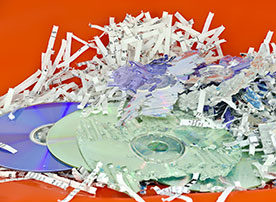Disposing of Records
Disposition is the final action in the records lifecycle and occurs when a record satisfies its retention period as noted on a retention schedule. You can learn more in our publication, The Records Lifecycle.
Disposition means the disposal of a record by (1) destruction, (2) transfer to an archival repository, or (3) transfer to another government or organization.
- The Archives’ State Wastepaper Recycling Contract offers free and confidential paper records destruction for state agencies and local governments. Destruction of microfilm, computer tapes and disks, video tapes and other magnetic media are not covered under this contract. Contact the State Records Center, records@nysed.gov, for a list of vendors.
- Local governments are responsible for preservation of records marked as “permanent” in their retention schedules. State agency retention schedules indicate that records with long-term historical value must be transferred to the State Archives following the Procedures for Transferring Records to the New York State Archives. The Archives has appraised these records and determined that they have enduring historical value.
- Under limited circumstances, local governments and state agencies may transfer custody of their records to another organization or government through donation, loan, or deposit. For more information on transferring records elsewhere legally, contact the State Archives at (518) 474-6926 or recmgmt@nysed.gov.
The key is to regularly carry out disposition, as indicated in your retention schedule and as part of your organization’s normal business practices, and to document this disposition. Documentation of disposition can protect your organization when it is unable to provide properly destroyed records in response to litigation, audits, or requests under FOIL. Organizations may use the State Archives’ sample records destruction authorization form; state agencies may save a copy of the records disposition notice received from the State Records Center.
Methods of Destruction
State law does not specify a destruction method for most records; however, it is best practice to securely destroy confidential records. Decisions regarding the method of destruction are usually left up to the organization. Various methods of destruction for paper and electronic records may be found in the publication, Retention and Disposition of Records: How Long to Keep Records and How to Destroy Them and on the Electronic Records webpage.

